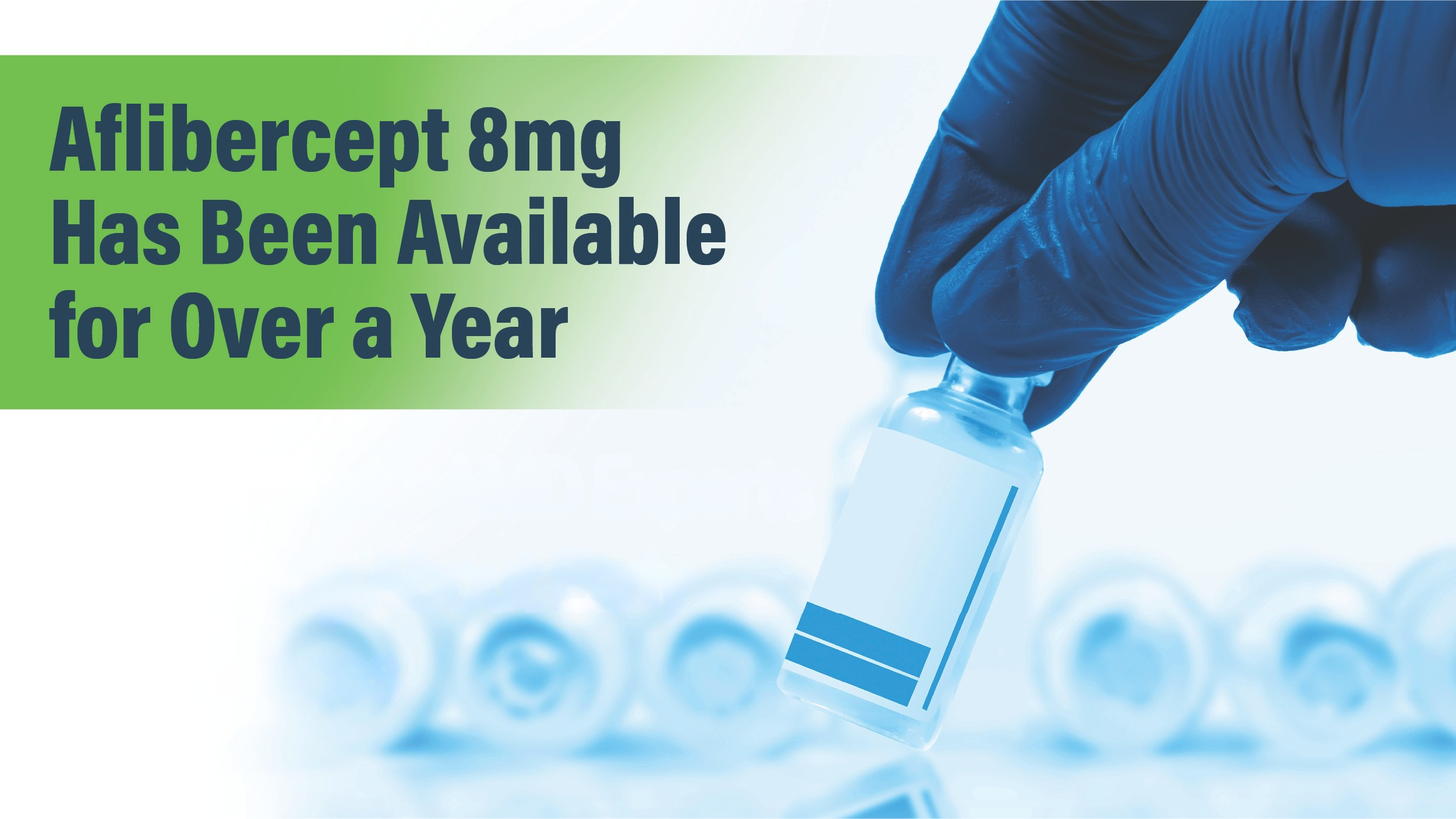Sponsored by Bayer
Drs. Justus Garweg and Kenneth Fan talk treatment regimens, clinical tips and switching to EYLEA 8mg as the anti-VEGF agent passes the one-year mark since approval.
Depending on what approved jurisdiction you’re in, EYLEA 8mg (aflibercept 8mg injection) has been available for over a year since the drug’s first regulatory approval in the European Union on January 8, 2024.
The EU approvals—and the global wave that followed—were based on robust clinical evidence from the PULSAR trial. These clinical trial findings demonstrated that EYLEA 8mg maintained visual acuity comparable to the 2mg formulation while allowing substantially longer intervals between treatments. Recent three-year data has shown 28% of patients had a last-assigned dosing interval of 6 months.1-3
Dr. Kenneth Fan (Retinal Consultants of Texas, United States) and Dr. Justus Garweg (Berner Augenklinik, Switzerland) have firsthand experience with aflibercept 8mg dating back to the drug’s time in clinical trials. Working with the drug in both the trial and the real-world settings has given them a wealth of perspective on EYLEA 8mg—and what it means for retinal medicine.
This perspective brings a wealth of insights for both doctors getting started with EYLEA 8mg and those who are already treating patients with it. From treatment regimens to loading doses, tips for mastering injection with the higher molar dose and more, there’s a lot to catch up on after the year that was with EYLEA 8mg.
“This is a pivotal moment in retinal care,” Dr. Fan said. “We now have the ability to achieve the same visual outcomes [as EYLEA 2mg] while significantly reducing the treatment burden for patients.”
Anatomical and functional improvements in treatment-naïve patients and switchers
Early anatomical response has been seen by EYLEA 8mg users like Drs. Garweg and Fan, particularly in treatment-naïve patients.
“In the treatment-naïve cases, one-third of the cases or close to one-third of the cases in our hands are already dry after our first injection, which is amazing,” said Dr. Garweg.
Dr. Fan attributes this rapid response to the higher molar concentration of aflibercept 8mg.
“I think short term response has been phenomenal, because you’re able to achieve a higher molar dose of anti-VEGF [compared to EYLEA 2mg] higher than ever achieved before by any other agent.” This aligns with PULSAR trial data showing that 63% of patients achieved were dry with EYLEA 8mg, versus 52% with the lower molar dose 2mg formulation at week 16.1
Functional improvements, which are key to patient compliance and quality of life, typically follow these anatomical responses. “In the treatment-naïve cases, the patients usually observe a significant or at least relevant vision gain after the first injection, and the maximum in their perception is normally reached after 3 injections,” noted Dr. Garweg.
However, both experts emphasize the importance of setting appropriate expectations, particularly for patients switching from other therapies.
“In the switcher cases, we do inform our cases that they do not gain on average, though there are exceptions” Dr. Garweg explained.
But that doesn’t detract from the viability of switching to EYLEA 8mg—far from it, according to Dr. Garweg. “The reason to switch is to reduce the treatment burden of those patients,” he said. Communicating such distinctions, he continued, are critical in managing expectations between treatment-naïve and switch patients and are crucial for patient buy-in, compliance and ultimately satisfaction.
Navigating the injection learning curve with a higher molar dose
EYLEA 8mg’s higher molar dose comes with a key consideration that requires adapting when switching from lower molar dose anti-VEGF agents like EYLEA 2mg: increased viscosity.
“Compared to the 2 milligram vial, the fluid is much more dense,” said Dr. Garweg. “As a result, you need much more vacuum [pressure], and that means more bubbles.”
If not managed properly, this can have a temporary negative effect on patients. “These bubbles can cause temporary visual disturbances for patients,” said Dr. Garweg.
Patients may, as a result, experience some transient visual phenomena after injection. “There are two points that are coming back from the patient on this. The first is black circles associated with the small bubble that you don’t get rid of. The second is that patients can have visual phenomena related to the high viscosity,” noted Dr. Garweg. However, these effects are generally well-tolerated and temporary.
So how to manage this properly? Dr. Garweg has a simple solution to help avoid this. “Get the vial to room temperature. If the drug has reached room temperature, it’s much more fluid, and that helps. You don’t need so much suction, and you can more readily get rid of the bubbles,” advised Dr. Garweg.
Despite these considerations, both clinicians report that the injection procedure itself is still as straightforward as with EYLEA 2mg. “There’s really not much of a difference with the other drugs that you have in a vial, except the viscosity and the bubbles,” Dr. Garweg said. “The higher injection volume has never been an issue in our site,” Dr. Garweg confirmed.
Dr. Fan shared similar experiences: “I didn’t have anyone say, oh, this felt unusual or this felt really different than what I’m used to,” he reported.
Both doctors emphasized that consistency in patient experience is particularly important when switching patients from other therapies, as it maintains their confidence in the treatment process—making handling potential viscosity issues especially important.
In certain approved areas, Bayer has introduced OcuClick, a prefilled syringe engineered for accuracy and patient comfort, for EYLEA 8mg—another boon to both the patient and practitioner experience when switching from other agents.
Patient selection: Identifying optimal candidates
Treatment naivete isn’t the only consideration when identifying which patients could benefit from treatment with Eylea HD. Both specialists emphasized that while a wide variety of patients could benefit from the drug, certain groups show particularly favorable responses.
Treatment-naïve patients are one. “With treatment-naïve patients, we’ve personally had really good response rates with 8 milligrams,” noted Dr. Fan.
Tricky patients who require more treatment constitute another group suitable for switching to EYLEA 8mg, according to Dr. Garweg. “Those cases with a high treatment demand, the frequent flyers… In my experience, 20% of those with persistent fluid get dry after the first injection,” he said.
One tip from Dr. Garweg for these challenging patients switching from other therapies: setting appropriate expectations is crucial for success. “If you have full control of disease activity in your cases, and then you switch them, you would not expect visual gain… The aim is to keep vision stable over a long time,” Dr. Garweg explained, echoing his previous comments about switching patients.
Dr. Fan has also keyed in on other patient populations based on specific anatomical situations and disease states. “I’ve actually had a pretty excellent response from patients with subretinal hemorrhage. With several loading doses of EYLEA 8mg we’ve been able to remove all that hemorrhage and extend them out very quickly,” he said.
He also mentioned good personal results in patients with polypoidal choroidal vasculopathy (PCV)—a potential treatment option for patients in approved jurisdictions in Asia, where PCV is more prevalent.
“I know that in Asia, there’s a higher prevalence of polypoidal choroidal vasculopathy. And there’s some great data on PCV lesions and response to EYLEA 8mg with that,” Dr. Fan said.
“So with my PCV patients, I usually try to get them to EYLEA 8mg, and I feel that they’ve actually had some really good responses with that as well.” These comments align with the data from recent PCV subgroup analyses from both the PULSAR trial for nAMD and PHOTON for diabetic macular edema (DME), which show encouraging data for drying speed, vision gains and lesion suppression.4
Long-term outcomes and quality of life: The real impact
One of EYLEA 8mg’s advantages is the ability to potentially extend patients in nAMD. Three-year data from PULSAR paints a picture supportive of this data, including many patients only needing injections twice a year: 77%, 58%, 40% and 24% were on last assigned dosing intervals of ≥3, ≥4, ≥5 and 6 months, respectively.3
Both Drs. Garweg and Fan have significant experience translating these intervals to the real world, and noted several key guideline benchmarks in extending patients with EYLEA 8mg.
When making extension decisions, both specialists emphasized the importance of functional metrics in tandem with complementary anatomical data. “Your decision is driven largely by functional response—so vision and fluid,” explained Dr. Fan. “If you’ve got a patient who dried up really well during the loading phase, those patients can go q8 and then q10, q12 pretty rapidly.”
Despite the data pointing to the potential to extend patients, Dr. Garweg believes a cautious approach will help reproduce optimal results when making the decision to extend in a clinical setting. “The only risk [with extending] is that you are too optimistic and overextend after the first injection, which means you might have recurrent fluid after the second injection,” Dr. Garweg said.
This underscores the importance of individualized treatment decisions based on careful monitoring—and echoes the importance of an approach based on both functional and anatomical response to treatment with the drug.
The clinical trial data support extension to longer intervals in a wide variety of patients—and in real-world practice, these two physicians are finding that many patients can achieve longer intervals, particularly after the first year of treatment.
After a year or more of experience with EYLEA 8mg, both Drs. Garweg and Fan have reported encouraging durability results from their firsthand experience. “After 1 year, I would say I gain an average of roughly 15% to 20% increase in treatment intervals in switch patients,” Dr. Garweg said.
Dr. Fan reports similar findings after over a year of clinical experience with EYLEA 8mg. “In some cases, I’ve got patients out to q4-months, which is the data that we saw in PULSAR,” he said, painting an encouraging picture of clinical trial results translating to the real world.
Perhaps most importantly for patients, both doctors have seen these extended treatment intervals translate into meaningful quality of life improvements.
For many of the elderly patients he sees in his Bern-based clinic, the largest impact is on family members. “If I reduce the treatment burden, I can also see a reduction in the social pressure for the patient when they come into the clinic, because they have to ask relatives or caregivers to bring them into the hospital less frequently,” Dr. Garweg explained.
Dr. Fan illustrated this with an observation of his own. “When you get that patient out to q12, q14 in someone who, let’s say, is wheelchair bound and their family has to bring them every time… that makes a big difference for them.” These practical benefits extend beyond visual outcomes to significantly impact patients’ overall wellbeing and independence.
Patient testimonials further highlight these benefits, with one of Dr. Fan’s patients reportedly being able to read “7-8 books” between injections due to extended treatment intervals, and other younger patients valuing the reduced disruption to travel and work commitments.
Conclusion: A valuable addition to the retinal specialist’s armamentarium
These firsthand experiences indicate that EYLEA 8mg represents an advancement in anti-VEGF therapy, offering comparable efficacy to the 2mg formulation with extended durability.
The safety profile remains consistent with the well-established 2mg formulation, with no new safety signals observed. This and the overall familiarity built up with EYLEA 2mg can be a source of confidence for both physicians and patients when transitioning to the higher-dose formulation.
As Dr. Fan summarizes: “Having an additional tool in our armamentarium of anti-VEGF has been fantastic… you can step to something even more potent, and having that extra option has been really great.”
This sentiment encapsulates the value of EYLEA 8mg in expanding treatment options for patients with retinal diseases, potentially transforming the existing anti-VEGF treatment paradigm by reducing treatment burden while maintaining visual outcomes.
Optimizing the Higher-Viscosity EYLEA 8mg Injection
- Temperature Management: “Get the vial to room temperature because if the drug has reached room temperature, it’s much more fluid, and that helps.” – Dr. Garweg
- Bubble Prevention: Use slower aspiration with less vacuum to minimize bubble formation. If bubbles appear, allow longer settling time before injection.
- Patient Communication: Inform patients about possible transient visual phenomena (black circles, visual disturbances) that may last up to 24 hours post-injection to reduce anxiety.
- Injection Technique: Standard injection techniques apply; no special modifications needed despite the higher volume (70µL vs. 50µL for 2mg).
Case Study: From Monthly to Every 4 Months with EYLEA 8mg
An 80-year-old female patient had received monthly anti-VEGF injections for nAMD for over 5 years with persistent fluid. After switching to EYLEA 8mg, Dr. Fan reports: “I started the patient on EYLEA 8mg, and very quickly after the loading phase, I was able to extend them to first every 8, then 10, then 12, and I think she’s now out to every 16 weeks.”
The patient was initially nervous about extending intervals after years of monthly treatment but has maintained stable vision with dry retina at 16-week intervals. This represents a reduction from 13-yearly injections to just 3-4, improving quality of life.
PP-EYL_8mg-ALL-0349-1
References
- Spitzer MS. Intravitreal aflibercept 8 mg injection in patients with neovascular age-related macular degeneration: 48-week results from the Phase 3 PULSAR trial. Invest Ophthalmol Vis Sci. 2023;64(8):461.
- Lanzetta P, Korobelnik JF, Heier JS, et al; PULSAR Investigators. Intravitreal aflibercept 8 mg in neovascular age-related macular degeneration (PULSAR): 48-week results from a randomised, double-masked, non-inferiority, phase 3 trial. Lancet. 2024;403(10432):1141-1152.
- Regeneron Pharmaceuticals. Press release. Available at: https://investor.regeneron.com/news-releases/news-release-details/three-year-results-eylea-hdr-aflibercept-injection-8-mg-patients Accessed on 31 March 2025.
- Wong TY, Heier JS, Zhang X, Machewitz T, Schulze A, Leal S; Intravitreal aflibercept 8 mg in patients with polypoidal choroidal vasculopathy (PCV): A Phase 3 PULSAR trial subgroup analysis. Invest Ophthalmol Vis Sci. 2023;64(8):2240.



